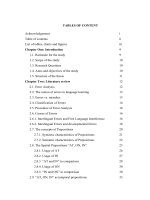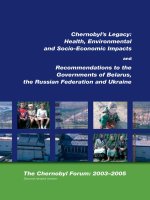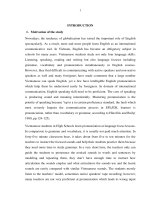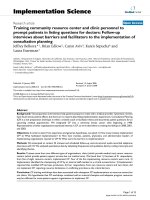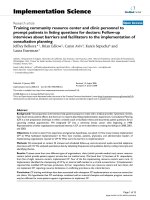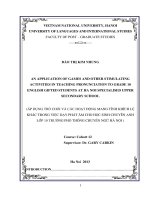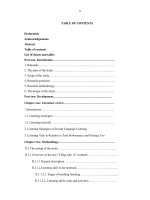Teachinh comparaticves and superlarives to the students of class 10a1 at quan son 2 upper secondaly school in quan son, thanh hoa, province
Bạn đang xem bản rút gọn của tài liệu. Xem và tải ngay bản đầy đủ của tài liệu tại đây (144.19 KB, 16 trang )
Table of content
Page
Chapter 1: Introduction…………………………………….... 2
1.1.
Rationale…………………………………………………………
3
1.2.
Research scope………………………………………………… … 3
1.3.
Aim of the study………………………………………………….. 3
1.4.
Methods of the study………………………………………………. .3
Chapter 2: Literature review…………………………….... .3
2.1. An overviewon Language Teaching Methods…………………………3
2.2. The Process of teaching comparatives and superlatives………………4
Chapter 3: The application of process approach
in teaching comparatives and superlatives to the
students of class 12A1 at Quan Son 2 Upper Secondary
school………………………………………………………………….13
3.1. The purpose………………………………………………………… .13
3.2. The participants……………………………………………………… 13
3.3. Time and the process of this application……………………………….14
Chapter 4:
Conclusion..................................................................
15
References
1
Chapter 1: Introduction
1.1 Rationale for the study
English may not be the most spoken language in the world, but it is the
official language in a large number of countries. It is estimated that the
number of people in the world that use in English to communicate on a
regular basis is 2 billion!
English is the dominant business language and it has become almost a
necessily for people to speak English if they are to enter a global workforce,
research from all over the world shows that cross-border business
communication is most often conducted in English. Its importance in the
global market place therefore cannot be understated, learning English really
can change your life.
In the National curriculum, English is one of the core subjects, which are
complusory in the high school final examination. Therefore, students have to
study all the English skills for their tests. However, there still exist many
difficulties facing teachers in teaching English to students, especially those
from ethnic minorities.
Quan Son is one of the mountainous districts of Thanh Hoa province.
The living condition and studying condition are poor and restrict. Most of
the students of Quan Son 2 upper – secondary school are ethnic minorities
such as Thai, Muong, Mong. Ethnic minority students mainly use their
mother tongue to communicate inside their families and small communities.
As a result, ethnic minority students fail to make progress in learning
English. Especially, they have many difficulties in learning English
grammar. One of the most difficult grammar parts that students have to face
is comparatives and superlatives.
For these reasons, I would like to choose the topic “teaching
Comparatives and superlatives to the students of
class 10A1 at Quan Son 2 upper- secondary school in
2
Quan Son, Thanh Hoa” in the hope of supplying upper-secondary
students, especially the students of class 10A1 at Quan Son 2 uppersecondary school with enough knowledge of comparatives and superlaives.
1.2. Reseach scope
The study focuces on applying process approach in teaching
comparatives and superlatives to the students who are in grade 10 so that they
can have enough knowledge to do exercises related with comparatives and
superlatives.
1.3. Aim of the study
The study is aimed to teach comparatives and superlatives for the grade10- students.
1.4. Methods of the study
In order to achieve the above aim, the teacher supplies or teaches the
necessary knowledge about process approach and an overview of comparatives
and superlatives to the students. After that, students will have time to practise
them and get feedback as well as correction from their friends and teacher.
Chapter 2: Literature review
2.1. An overview on Language Teaching Methods
In the discussion of the history of Language Teaching Methods, it can be
understandable that a teaching method which may be effective at one point of
time in history may still be ineffective at the other point. This dynamic
character of the language teaching goals make the history of foreign language
teaching ever-changing, ever-adapting. Moreover, one method is replaced by
another it does not mean that the former is worse than the latter and will be
thrown into the wastebasket of history. It only means that the replaced method
fails to correspond to a certain need at a certain time in history. As a result, the
history of foreign language teaching method is not the history of replacement
of one method by another. Rather, it would be the history of adapting one new
method to the treasury of existing methods. A number of methods have been
3
envolved for the teaching of English and also other foreign language in the
past; howerver in Viet Nam three method which enjoy significant use and
dominate the language teaching are the Grammar – Translation, the Audio –
lingual method and the Communicative language teaching.
2.2.The process of teaching comparatives and superlatives
Theory of comparatives and superlatives
Most English adjectives are short words and form their comparatives
and superlatives using particles
-er-----------------than for comparatives.
-est---------------- in for superlatives.
in other cases longer forms are preferred, as follows
more…………..than
the most …………………in
* spelling of shorter comparatives and superlatives.
+ One syllable adjectives simply ad the ending to their basic forms,
clean-------------cleaner---------------the cleanes
hard -------------harder----------------the hardest
+ When a short adjective contains the group:
fat---------------fatter-----------------the fattest
sad-------------sadder---------------the saddest
thin-------------thinner---------------the thinnest
+ Whenever the adjective ends in '-e', it only adds -r or -st
nice-------------nicer------------------the nicest
late--------------later------------------the latest.
+ Some two-syllable adjectives end in '-y' and form their comparative by
changing into '-i' + -er/-est:
4
tidy------------------tidier---------------the tidiest
busy----------------busier--------------the busiest
but shy------------shyer---------------the shyest
+ The following endings in two-syllable adjectives form regular comparatives
and superlatives
-er------------clever------------cleverer-------------the cleverest
-le------------humble----------humbler-------------the humblest
-ow-----------narrow----------narrower------------the narrowest
and others as well:
pleasant-------------pleasanter---------------the pleasantest
common-------------commoner---------------the commonest
However, it is safer to use the longer form with 'more' and 'most for 1.5
more humble than-------------the most humble
more pleasant than-----------the most pleasant.
* Some adjectives have specific irregular forms. These are the most
common:
good---------------better---------------the best
bad-----------------worse--------------the worst
far-------------------farther-------------the farthest
much---------------more --------------the most
many
* Comparison and superlative of longer adjectives.
Some adjectives always use the longer comparison structure:
more…..than
the most ………………in/of
5
+ Adjectives of two syllables ending in known suffixes
famous-------------more famous than------------the most famous
careful--------------more careful-------------------the most careful
expensive----------more expensive--------------the most expensive
boring/bored-------more bored/boring----------the most boring/bored
* Most can mean the largest majority of
'Most doctors recommend not to smoke.'
* Comparatives with '-er and -er'
two comparatives, of any kind, joined by 'and' can convey the idea of increase
or decrease. Usually verbs like, GET, GROW or BECOME are used.
My children are getting taller and taller.
Travelling abroad has become MORE AND MORE EXPENSIVE.
* The + comparative+ the + comparative
this structure implies a cause - effect relationship between both adjectives. It
can take place with both short and long comparatives, either adjectives or
adverbs(1)
The faster(1) she walks, the thirstier she gets.
The longer he talked, the more interested they looked.
* Intensifiers with the comparative .
a bit---------------a bit colder than
much--------------much more interesting
a lot--------------a lot more careful
+ Intensifiers with the superlative.
Ex. This is by far the most dangerous mountain
It much the most expensive bit of land in the city.
* Other comparative structures.
6
These comparative structures are very frequent and should be remembered.
Switzerland is twice as expensive as Spain = more expensive and double.
Boys are three times as likely to have accidents as girls
* The same as/different from
He doesn't earn the same as she ( does )
Or with a verb
Valencia didn't play the same way as they used to
We have a different car from last year
Or
We played in a different way from last year/………differently from last year
* as………….as to indicate the same degree/ not so…………..as for lower
degree.
Some motorbikes are as expensive as cars
A cat is not so faithful as a dog
with nouns much and many becomes necessary.
They haven't got as much oxygen as they think, so they'll have to come down
We need as many blankets as possible for the injured people.
* AS / LIKE
LIKE is a `preposition and is followed by noun or pronoun:
She's like her mother: always laughing
AS is a conjunction and is followed by a clause with a subject and a verb.
When in Rome do as the Romans do.
* AS IF / AS THOUGH.
Both are used in the same way in comparisons. They are followed by a
past tense with a present meaning and WERE for the verb 'to be'.
7
It looks as if it had rained a lot around here.
He looks as if he were the happiest man on earth.
REVISION EXERCISES.
Exercise 1: Put the adjectives in brackets into the form which best suits the
meaning of the sentence.
1 That is__________ (incredible) story I have ever heard!
2 It is not always__________ (bright) students who do well in tests.
3 Fibre shirts are harder-wearing, but cotton shirts are
much__________ (comfortable),
4 Which is __________(deep), Lake Garda or Lake Iseo ?
5 She is much__________ (self-confident) than she used to be.
6__________ (tall) man in Manresa is a basketball player.
7 I like both of them, but I think Michael is __________(easy) to talk to.
8 Most people are__________ (well off) than their parents were.
9 She has a lot to be thankful for__________________(sad) thing of all is that
she does not realize it.
10 I want to rent a car -__________ (powerful) one you have.
11 You look a lot__________ (well) than you did last time I
saw you.
12 There is nothing__________ (irritating) than locking yourself out of your
own house.
13 Both roads lead to the city centre, but the left-hand one is probably a
bit__________ (short) and__________(direct). .
14 As I get__________ (old), I notice that the policemen seem to be getting
__________(young)!
15 Nothing could be__________ (fine) than to be in Carolina. (song title)
16 'Is Cambridge __________(old) university in Britain?' 'No, Oxford is about
50 years__________ (old).'
8
17 If you were__________ (tidy) and __________(well-organized) than you
are, you would not keep losing things.
18 The boys in our school are much__________ (good- looking) and a lot
__________(good) at football than the boys in other schools in the town.
Exercise 2:
1. Aeroplanes are generally__________ (fast) than helicopters.
2. Since I bought my car, I have__________ (little) money than I did before.
3. Pompeu Fabra University is not__________ (old) the Barcelona University.
4. The weather today is much__________ (warm) than it was yesterday.
5. I can't babysit for your baby brother. I haven't got__________ (much)
patience as I used to.
6. Mar's dad bought her a puppy yesterday. It was __________ (good) present
she has ever received.
7. In England, the name Tom is__________ (common) than the name Wilbur.
8. The damage was far __________(bad) than we had expected.
9. Trevor is just __________ (active) Alan in student politics. ,
10. The new pupil is __________(clever) at English than many of the other
pupils in his class.
11. I think that is__________ (beautiful) painting I've ever seen.
12. It looks like there are__________ (few) people at the party than we
expected.
13. Flights to England are__________ (frequent) than flights to China from this
airport.
14. My sister cooked the__________ (bad) meal I have ever eaten.
15. Xavier is not__________ (short) than his sister.
16. This gallery is not__________ (interesting) the one we saw in Florence.
17. My shoes are in__________ (good) condition than yours.
9
18. It is .__________ (noisy) in the city centre than it is in the suburbs.
Exercise 3: Fill in the blanks with the superlative form of the adjective in
brackets.
1. London is ___________(large) city in England
2. The Alps are__________ (high) mountains in Europe.
3. According to the map, this is __________ (direct) route to Barcelona.
4. That was__________ (bad) film I have ever seen.
5. I did not enjoy that book. It was__________ (exciting) out of all the books
I've read.
6. David is__________ (funny) person I know.
7. The old city of Florence is__________ (interesting) city in Italy.
8. This is__________ (delicious) spaghetti I have ever eaten.
9. Your friend is__________ (unpleasant) person I've ever met. I hope I never
see him again.
10. What is__________ (good) way to get to Roger's house?
Exercise 4
1. Peter is the……………. student in my class.
a. taller than
2.
4.
b. strange
c. as strange as
d. stranger
a. more intelligent as
b. intelligent as
c. so intelligent as
d. so intelligent that
He drives as……………. his father does.
b. more carefully c. the most careful d. carefully as
What's the………….film you've ever seen?
a. good
6.
d. tallest
Jane is not………………..her brother.
a. careful as
5.
c. the tallest
The deep oceans contain some of the…………..of all living creatures.
a. strangest
3.
b. so tall as
b. best
c. better
Jane is…………..age as Mary.
10
d. the best
a. as same
7.
b. no sooner as
c. as soon as
d. soonest as
Hotels have developed………….. restaurants.
a. as rapidly as
9.
d. more same
I'll be there……………I can.
a. sooner as
8.
b. the most same c. the same
b. so rapidly that c. as rapid as
d. as rapid than
Commercial centres are…………..they were many years ago.
a. as popular than b. the most popular.
c. more popular than d. most popular than
10. Computer are considered as………… tools today
a. much modern than
b. the most modern
c. modern as
d. more modern
11. A supermarket is…………..a shopping centre.
a. less convenient as
b. not so convenient than
c. less convenient than
d. the most convenient as
12. Vietnam becomes………………to foreign tourists.
a. most and most attractive
b. the more attractive
c. much and ore attractive
d. more and more attractive
13. Can Tho is………………from Saigon than Bien Hoa is.
a. farther
b. further
c. far
d. farer
14. Bao Yen sings……………..than this singer.
a. well
b. better
c. gooder
d. more good
15. Of all the ball-point pens, which one do you like…………….?
a. best
b. the best
c. most
d. the most
16. The…………..we start, the sooner we will be back.
a. early
b. earliest
c. earlier
d. more early
c. good
d. more good.
17. The sooner, the……………..______
a. better
b. best
18. The harder this farmer works,…………….he becomes.
a. the poorest
b. the poorer
c. the more poor
19. My father is………………as yours.
11
d. poorer
a. old
b. as old
c. older
d. so old
20. HCM city is………………than Hanoi.
a. large
b. largest
c. more large
d. larger
* Keys:
Exercise 1:
1. the most incredible
10. the most powerful
2. brighter
11. better
3. more comfortable
12. more irritating
4. deeper
13. shorter – director
5. more confident
14. older – younger
6. the tallest
15. finer
7. easier
16. the oldest – older
8. better off
17. tidier – more well – organized
9. the saddest
18. more goog – looking, better
Exercise 2:
1. faster
10. cleverer
2. less
11. the most beautiful
3. the oldest
12. less
4. warmer
13. more frequent
5. more
14. the worst
6. the best
15. shorter
7. more common
16. more interesting
8. worse
17. better
9. the most active
18. noisier
12
Exercise 3:
1. the largest
6. the funniest
2. higher
7. the most interesting
3. the directest
8. the most delicious
4. the saddest
9. the most unpleasant
5. the most exciting
10. the best
Exercise 4:
1d
11c
2a
12d
3c
13a
4d
14b
5b
15a
6c
16c
7c
17a
8a
18b
9b
19b
10b
20d
Chapter 3: The application of process approach in
teaching
comparatives
students
of
class
and
12A1
at
superlatives
Quan
Son
to
2
the
Upper
Secondary school
3.1.The purpose
The application is aimed at teaching comparatives and superlatives
through process approach for the students of class 10A1 at Quan Son 2
upper secondary school then improving English grammar for them. From
this, they will prepare better for their tests and may get good mark for this
part.
3.2. The participants
The application is carried out with 38 students of the class 10A1 who
have been learning English for 5 years( 4 years at lower secondary school
with English 6,7, 8, 9 and 1 years at upper secondary school with English
10). These students are from Quan Son 2 Upper Secondar School in Quan
Son, Thanh Hoa.
13
Among 38 students who take part in the study, about one- third of them
has good knowledge in English and the rest are not interested in learning, so
they do not have enough vocabulary as well as structure to master English
grammar.
3.3.Time and the process of the application
The study is carried out on extra lessons on Thursday and Saturday
afternoons of the class 10A1. Each lesson last 45 minutes. The study lasts a
month ( from March,10th, 2016 to April,10th 2016) with 12 lessons.
The teacher teaches related knowledge( as mentioned in Literature
review) and gets the students to practise the process,then give feedback and
correction.
The teacher followed these stages below:
+ Stage 1: The teacher used traditional method: providing the students
with the full theory of comparatives and superlatives and then giving them
examples to illustrate.
+ Stage 2: The teacher asked the students to do lots of exercises and
checks their results.
• Students’ results based on the first survey:
Class
Number
10A1
38
Distinction
No
%
Credit
No
%
Pass
No
%
Weekness
No
%
0
7
19
12
0
18,4
50
31,6
+ Stage 3: Because of the students’ low results, the teacher was really
worried about the students’ study. The teacher disscussed the problem with
other teachers. Moreover, the teacher directly talked with the students about the
difficulty that they were facing with. The result showed that the method the
teacher used was not suitable. It was too fast that the students couldn’t catch up
with the entire theory of comparatives and superlatives, which the teacher
provided them. The teacher realized that there might be a change in teaching
method.
+ Stage 4 : During reviewing periods, the teacher tried to applied a new
teaching method. With the knowledge system as above, the teacher proceeded
as follows:
14
- Firstly, the teacher gave examples and analysted stuents understand.
- Secondly, the teacher draw the formula from the examples.
- Next, the teacher began to provide the theory of comparatives and
superlatives for the students.
- After that, the teacher gave students another examples to help them
understand more.
+ Stage 5 : After applying the new teaching method, the teacher did survey
again and received better results as follows:
• Students’ results based on the second survey:
Class Number
10A1
38
Distinction
No
%
Credit
No
%
Pass
No
%
Weekness
No
%
1
14
18
5
2,6
36,8
47,4
13,2
Chapter 4: Conclusion
I have mentioned before, ethnic minority students of class 10A1 at Quan
Son 2 high school are not good at English. This makes students usually feel
tired and bored and don’t concern about this subject, so the teacher should
combine all activities to creat excitement for students and make stuents love
English.
This is my own experience in teaching comparatives and superlatives to
the students of class 10A1 this school year. I believe that the students will
have more confidence in their study. I hope this method can be applied in
our school widely. Finally, I do hope to receive ideas from other teachers so
as to have the better study.
References
15
Hoµng V¨n V©n( Chñ biªn)( 2011) TiÕng Anh 10, Nhµ xuÊt b¶n
gi¸o dôc ViÖt Nam
Jeremy Harmer( 2008), How to teach English, Longman
Brow, H. Doughlas( 2001), Teaching by principles, New York Pearson
Education
Randolph Quirk (2003), A University Grammar of English, Nhà xuất bản Hải
Phòng
Raymond Murphy (2003), Essential Grammar In Use, Nhà xuất bản Giao
thông vận tải
16
